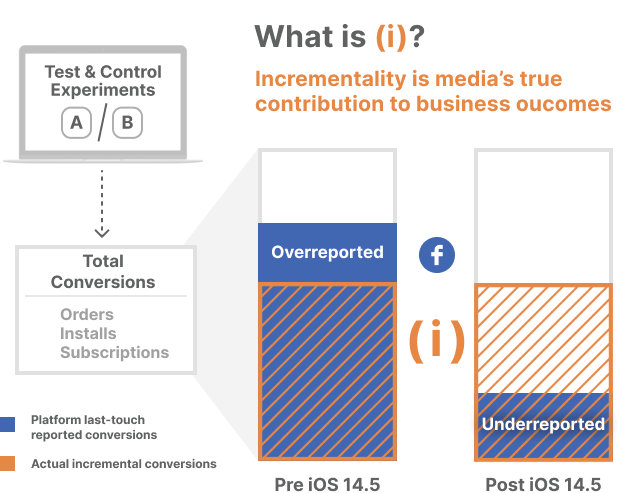Last week, just before its huge earnings miss was attributed to Apple’s privacy restrictions, Meta published this article encouraging advertisers to run incrementality experiments to get an accurate read on Facebook campaigns in the post-iOS 14.5 world. If it sounds familiar, well that’s because the narrative is nearly identical to the story we’ve been telling for years.
So, why are platforms just now coming around to acknowledge that incrementality testing is the most accurate method for measurement?
Apple is a convenient distraction and scapegoat for platforms to blame their current measurement and tracking issues on, but the truth is that Facebook reporting was never reliable in the first place. Pre-iOS14.5, the flawed last-touch attribution methods long used by most ad platforms made them look good. Now, increasing data restrictions are simply exposing platform attribution for the broken system that it is.
Before the collapse of user-level tracking, incrementality measurement often revealed that platforms like Facebook were overreporting conversions. The propensity for ad platforms to claim more credit than they deserve was due to the known inherent flaws of using last-touch metrics. By counting every conversion an ad was in the path, Facebook ignored the fact that some of those events would have happened anyway, not to mention the impact of ads from other vendors that they have always been blind to. The amount of extra credit could vary widely by audience type – think prospecting (mild) vs. retargeting (heavy).
Today, having lost the ability to track conversions for a significant segment of their users, Facebook is now vastly underreporting conversions, and testing for incrementality is suddenly the ideal approach to measurement. Incrementality experiments and geo-matched market testing can prove the value of campaigns on the platform while their own reporting systems cannot.

In an industry dizzy with inconsistency, incrementality is the one thing that remains consistent. Underreporting? Overreporting? Oversaturated? Underfunded? Testing for incrementality will consistently deliver valuable and actionable insights.
We work with more than 100 DTC brands, and every single one of them has some level of media budget being invested into Facebook. Some advertisers we work with are using incrementality testing to justify their continued investment in Facebook or to expand into things like reach optimized campaigns, knowing their campaigns are performing better than Facebook attribution would lead them to believe.
Other brands want to diversify away from steadily rising Facebook ad costs and are using incrementality experiments to test and scale into new channels like TikTok, Snap, Pinterest, or CTV. With incrementality and geo testing, marketers can spend a small fraction of budget to understand how allocating new significant investment into these channels will pay off.
We’re glad to see the platforms come around on incrementality and geo. Not just because they are helping us spread the word, but because it really is crucial for DTC brands – and for an industry that has been plagued with trust issues as far back as I can remember.
Incrementality measurement doesn’t require tracking at the user level, it can be run independent of potential platform bias, it’s rooted in proven scientific methodology, and it can provide ongoing insight at a tactical level so advertisers can continuously move dollars to where they drive the greatest business impact.
I’m not saying decisions by Apple, Google, and others haven’t had or won’t have a significant impact on the media industry and businesses that operate within it, but when it comes to platform attribution, nothing has changed. Facebook and other walled gardens were perfectly happy with a broken last-touch system of measurement when it provided results in their favor. My, how the tables have turned.
In any event, it has never been more clear that incrementality testing and experimentation could finally put to bed a decades-long struggle, for platforms and marketers alike, and become the standard advertising measurement approach that is useful and acceptable for everyone involved.
Measured.com – You can read the full article also here.
You want to contribute? Please, we are waiting for you: